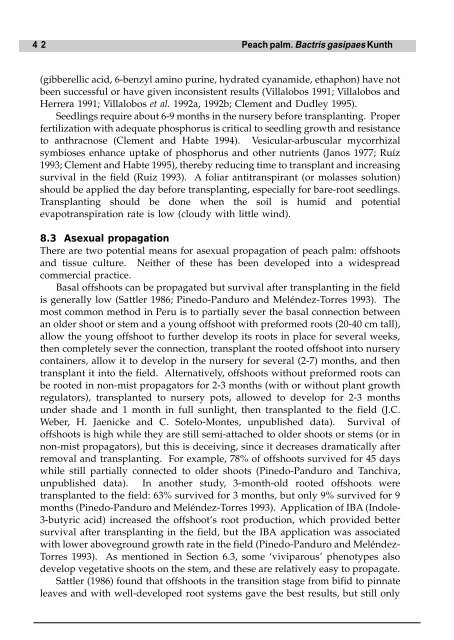Peach palm - World Agroforestry Centre
Peach palm - World Agroforestry Centre
Peach palm - World Agroforestry Centre
Create successful ePaper yourself
Turn your PDF publications into a flip-book with our unique Google optimized e-Paper software.
4 2 <strong>Peach</strong> <strong>palm</strong>. Bactris gasipaes Kunth<br />
(gibberellic acid, 6-benzyl amino purine, hydrated cyanamide, ethaphon) have not<br />
been successful or have given inconsistent results (Villalobos 1991; Villalobos and<br />
Herrera 1991; Villalobos et al. 1992a, 1992b; Clement and Dudley 1995).<br />
Seedlings require about 6-9 months in the nursery before transplanting. Proper<br />
fertilization with adequate phosphorus is critical to seedling growth and resistance<br />
to anthracnose (Clement and Habte 1994). Vesicular-arbuscular mycorrhizal<br />
symbioses enhance uptake of phosphorus and other nutrients (Janos 1977; Ruíz<br />
1993; Clement and Habte 1995), thereby reducing time to transplant and increasing<br />
survival in the field (Ruiz 1993). A foliar antitranspirant (or molasses solution)<br />
should be applied the day before transplanting, especially for bare-root seedlings.<br />
Transplanting should be done when the soil is humid and potential<br />
evapotranspiration rate is low (cloudy with little wind).<br />
8.3 Asexual propagation<br />
There are two potential means for asexual propagation of peach <strong>palm</strong>: offshoots<br />
and tissue culture. Neither of these has been developed into a widespread<br />
commercial practice.<br />
Basal offshoots can be propagated but survival after transplanting in the field<br />
is generally low (Sattler 1986; Pinedo-Panduro and Meléndez-Torres 1993). The<br />
most common method in Peru is to partially sever the basal connection between<br />
an older shoot or stem and a young offshoot with preformed roots (20-40 cm tall),<br />
allow the young offshoot to further develop its roots in place for several weeks,<br />
then completely sever the connection, transplant the rooted offshoot into nursery<br />
containers, allow it to develop in the nursery for several (2-7) months, and then<br />
transplant it into the field. Alternatively, offshoots without preformed roots can<br />
be rooted in non-mist propagators for 2-3 months (with or without plant growth<br />
regulators), transplanted to nursery pots, allowed to develop for 2-3 months<br />
under shade and 1 month in full sunlight, then transplanted to the field (J.C.<br />
Weber, H. Jaenicke and C. Sotelo-Montes, unpublished data). Survival of<br />
offshoots is high while they are still semi-attached to older shoots or stems (or in<br />
non-mist propagators), but this is deceiving, since it decreases dramatically after<br />
removal and transplanting. For example, 78% of offshoots survived for 45 days<br />
while still partially connected to older shoots (Pinedo-Panduro and Tanchiva,<br />
unpublished data). In another study, 3-month-old rooted offshoots were<br />
transplanted to the field: 63% survived for 3 months, but only 9% survived for 9<br />
months (Pinedo-Panduro and Meléndez-Torres 1993). Application of IBA (Indole-<br />
3-butyric acid) increased the offshoot’s root production, which provided better<br />
survival after transplanting in the field, but the IBA application was associated<br />
with lower aboveground growth rate in the field (Pinedo-Panduro and Meléndez-<br />
Torres 1993). As mentioned in Section 6.3, some ‘viviparous’ phenotypes also<br />
develop vegetative shoots on the stem, and these are relatively easy to propagate.<br />
Sattler (1986) found that offshoots in the transition stage from bifid to pinnate<br />
leaves and with well-developed root systems gave the best results, but still only

















